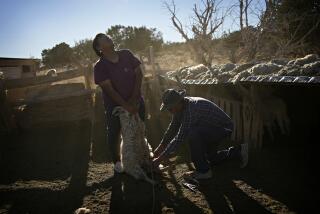Tractors Plow a Furrow Between the Amish : Oklahoma: Community leaders voted to allow farmers to replace horses with motors because of the hard soil in the region. Those against are neither complaining nor condemning; they’re leaving.
- Share via
CLARITA, Okla. — Herman Stutzman works a proud Amish farm--282 acres, 48 dairy cows and 30 sows, a small garden and rows and rows of wheat and other crops. Draft horses pull his mower and rake, and draw his carriage for trips to church or to town.
But when the time comes to bale hay, to till his field and to plant wheat, the horses will stay in the stables.
Stutzman will use his tractor.
Contemplated for several years because of the hard soil in this area 100 miles southeast of Oklahoma City, Amish leaders voted last fall to allow tractors--instead of horses, as is the tradition--to handle field work.
Those who argued against tractors are neither complaining nor condemning. They’re leaving.
“A lot of families are moving out, not just because of the tractors. This is a small part of the whole picture,” said Elmer Yoder, who builds houses and does light farming. “The issue is whether to retain the traditional lifestyle or whether we want to keep making changes and get away from the mainstream of Amish society.”
Traditionalists believe tractors could lead to more mobility and scatter families; they warn of commercialized farming and debt.
Steve Scott, a researcher at an Amish and Mennonite educational center in Pennsylvania called the People’s Place, said some Amish have introduced tractors over the years. In fact, Oklahoma’s other Amish community, located 40 miles east of Tulsa in Chouteau, already uses tractors.
But the Amish who came to Clarita in the mid-1970s, many of them from Ohio and Indiana, were of a more conservative strain and adhered to the strictest disciplines.
“When I first moved here, it was conservative,” Daniel Mast said in his weaving shop. “It didn’t quite turn out the way we thought, but we don’t hold anything against anyone.”
Mast, who opposes tractors because “they’re just too handy to run around on the road,” said he and his wife plan to move to Iowa by the end of the year, although he says being closer to his daughters--not the tractor dispute--led to that decision.
He declined to say how deeply tractors divided the community. Other Amish also explained the decision, but would not criticize it or denounce those who supported the idea.
“That’s generally what they do. Instead of having ill feelings, one group generally decides to move away,” said John Hostetler, a professor emeritus at Temple University and a leading expert on the Amish. “I guess we call that polarization in the English world.”
The evidence of the strife is found in “For Sale” signs along state Highway 48, where traffic signs alerting motorists of horse-drawn carriages also are posted.
Yoder’s 90-acre farm is for sale. His neighbor, a cabinetmaker, also is moving out. Yoder said as many as 10 of the 26 Amish families could be leaving, “depending on how the situation plays out.” Three families already have bought land in southeast Missouri.
“I can’t say there are no hard feelings because people are leaving,” Stutzman said while hosing down a farrowing barn for his next batch of pigs. “If I know what I am doing is causing ill feelings . . . I don’t enjoy that.”
But he felt relief when the church approved tractors.
“We’ve all seen how horses have limited what we can do,” he said. “We could have kept going the way we did, but it would be long and hard for somebody starting from scratch doing it the way we were.
“Black soil works hard. As far as planting, it takes a lot more horsepower.”
The black soil attracted the first Amish families to Coal County because, Mast says, that color soil was known to be fertile in the Midwest.
In southeastern Oklahoma, it turned out to be more hit-and-miss. Before his milk-cooling system failed, Mast had a dairy farm on 160 acres. Part of the land was rocky; other sections sprouted bountiful gardens.
“In Ohio, black land was good land,” he said. “When they were coming through, they saw this black land and said, ‘Here’s what we want.’ But it’s entirely different black land.”
One lifelong Clarita resident, who declined to give his name, told of an Amish man who toiled all day to till one strip of his land. Then a neighboring farmer on a tractor plowed the same amount of land in 15 minutes.
“They maybe should have turned a few shovels before they bought the land,” he said.
Yoder acknowledges that the terrain is different than in the Northeast, where the Amish first settled in this country in 1720, and “we have to adapt to a certain extent.”
They did so by hiring outsiders to do field work when it was too much for the horses. Stutzman said that got costly, so much so that Amish farmers became limited in what they could farm.
“I’m not saying it wouldn’t have been possible” to make a living without tractors, he said. “We were, as far as operations, very limited. We were hiring out all of our tilling. We’d do as little as we could to get by . . . and didn’t get a good crop because of it.”
The Amish are well-liked and respected in Clarita, an unincorporated town with no paved streets and only about 40 non-Amish residents. They worked alongside their neighbors when a fire station was built about 10 years ago, and some became volunteer firefighters.
Bill Patton, who for years lived next door to an Amish man who built buggies, said he was surprised to see the Amish divided.
“I felt they were a clan that got along real well,” he said. “But I see they have problems just like we do.”
More to Read
Sign up for Essential California
The most important California stories and recommendations in your inbox every morning.
You may occasionally receive promotional content from the Los Angeles Times.











